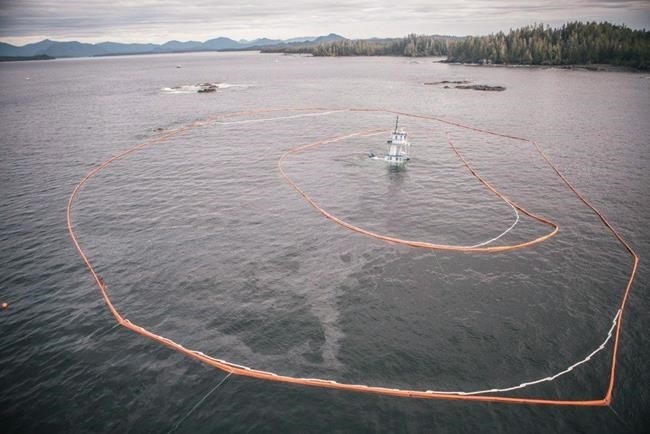
The tugboat Nathan E. Stewart lies submerged at the mouth of the Seaforth Channel near Bella Coola, B.C., shown in a handout photo from the Canadian Coast Guard. The chief of a First Nation community says choppy weather hindered efforts Friday to deploy a larger boom to better contain a leak of diesel fuel from a sunken tugboat on British Columbia's central coast.
Image Credit: THE CANADIAN PRESS/HO-Canadian Coast Guard
October 22, 2016 - 1:15 PM
BELLA BELLA, B.C. - The chief of a First Nation community says choppy weather hindered efforts Friday to deploy a larger boom to better contain a leak of diesel fuel from a sunken tugboat on British Columbia's central coast.
Heiltsuk Chief Marilyn Slett says a boom that was installed earlier became caught on a rock at low tide Thursday night and allowed an unknown amount of diesel to seep into open water.
A situation report issued Friday morning said water outside the containment booms appeared discoloured after the breach was discovered, but skimmer vessels failed to detect any diesel after the area was skimmed.
The Nathan E. Stewart tug ran aground while pulling an empty fuel barge through Seaforth Channel, about 20 kilometres west of Bella Bella, shortly after midnight on Oct. 13.
NDP Leader John Horgan visited the spill site at the invitation of the Heiltsuk Nation and raised concern Friday about the impact the incident would have on the fishery.
"It's one thing to say it's close to the clam beds but in this case it's right at the mouth of the entrance to what has been the food basket for Heiltsuk for millennia and it's compromised now as a result of this," Horgan said from Bella Bella.
"That's the real tragedy here."
Fisheries and Oceans Canada closed nearby shellfish harvesting on Oct. 14. The closure near Athlone Island in Seaforth Channel affects recreational, aboriginal and commercial fisheries for clam, geoduck, horseclam, oyster and scallops.
The Fisheries and Oceans notice said there was already a closure in the area because of red tide, or paralytic shellfish poison, that is caused by toxins.
Horgan said a spill-response centre is needed on the central coast to improve disaster response.
Salvage crews have recovered more than 40 per cent of the 200,000 litres of fuel estimated to be in the vessel.
News from © The Canadian Press, 2016